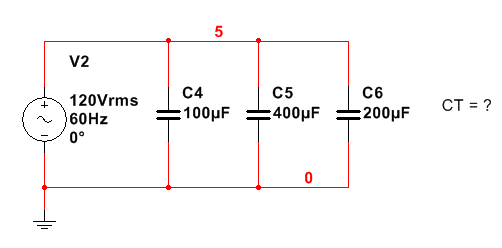Fundamental Properties of AC Circuits/Lab Course
PLEASE SEPARATE EACH ASSIGNMENT ON DIFFERENT WORD DOCS
Capacitance and Capacitive Reactance
- How much charge (Q) is stored in a 5uF capacitor connected across a 70V supply?
- How much charge (Q) is stored in a 20uF capacitor connected across a 70V supply?
- For a constant supply voltage and an increasing value of capacitance, what is the effect on the amount of charge (Q)? Explain your reasoning.
- For a constant supply voltage and a decreasing value of capacitance, what is the effect on the amount of charge (Q)?
- For 50kV applied across a 250pF capacitor, what is the stored energy?
- For a fixed frequency of f= 200Hz and the values of C below, determine XC:
- C = 1.0uF Xc = ?
- C = 0.5uF Xc = ?
- C = 0.2uF Xc = ?
- C = 0.1uF Xc = ?
- Determine the following:
- XcT for two capacitors in series with the values Xc1 = 300ohms and Xc2 = 400ohms
- XcEQ for three capacitors in parallel with the values Xc1 = 100ohms, Xc2 = 400ohms and Xc3 = 200ohms
- For the circuits below, determine CEQ and CT respectively:


Capacitive Reactance
- Watch the videos
- Week 2 Video Lecture – Capacitive Reactance (WILL GIVE LOGIN TO VIEW VIDEO IF NEEDED)
- Consider the circuit below:
 For each value of the frequency in the chart below, perform calculations for Ic, Vc and Xc.
For each value of the frequency in the chart below, perform calculations for Ic, Vc and Xc.
Frequency Calculated Ic Calculated Vc Calculated XC Measured IC Measured Vc XC (From Measured) 100 Hz 500 Hz 1000 Hz 1500 Hz 10000 Hz 20000 Hz - Construct the circuit with MultiSIM using a 10% tolerance for the capacitor.
*Note: One way to set the tolerance on a component is to do the following:
- Double-click on the component and select the Value tab.
- Select or enter the desired value in the Tolerance field and click OK.
- Complete the chart by adjusting the values of frequency and measuring Ic and Vc using the Agilent Multi-meter and then from these values calculating the value of Xc in the last column.*Note: Current is measured in series with the capacitor and voltage is measured in parallel (across) the capacitor. Capture screenshots showing the measured values of Ic and Vc using the Agilent Multi-meter.
- Discuss the following:
- Describe the relationship between the frequency and the capacitive reactance.
- What effect does frequency have on Ic and Vc for a fixed value of capacitance in this circuit?
- For a frequency of 1000Hz, what would be the effect of increasing the value of the capacitor on the current Ic and the voltage Vc?
- Why is it necessary to measure current in series with a device and voltage across it?
- Why is it necessary to determine Xc from measured values of current and voltage as opposed to measuring it directly with a digital multi-meter? (It may be helpful to perform research on the internet to gain more insight into the topic of this question.)
Include all calculations, screenshot of measurements, the table results of part 2 and the answers to part 5 in a word processing document
